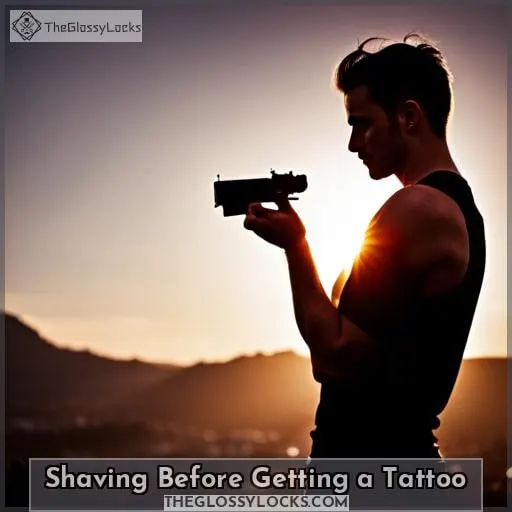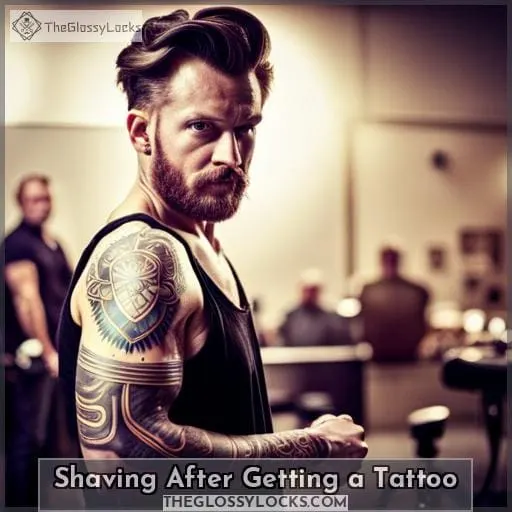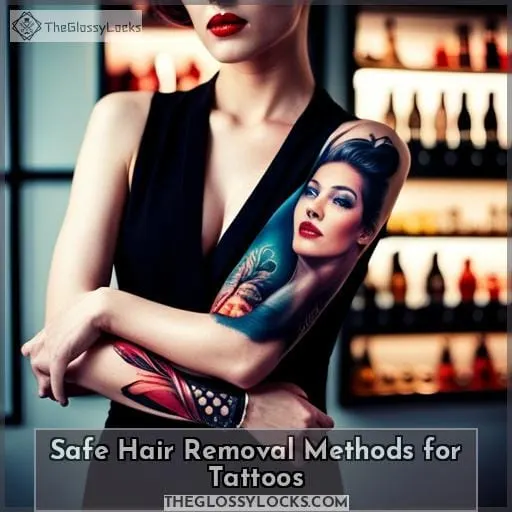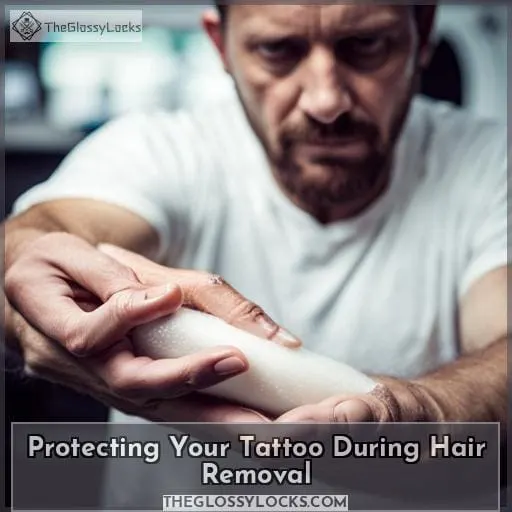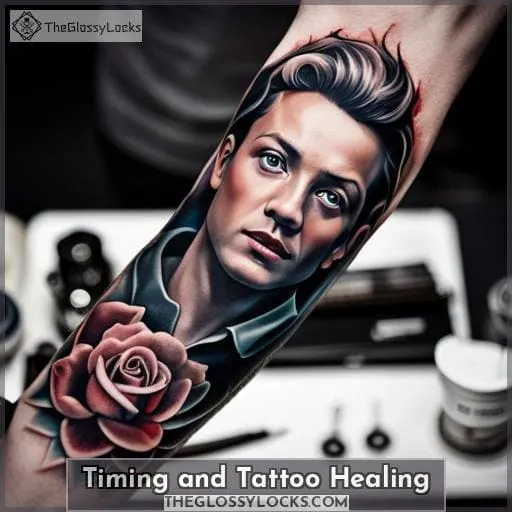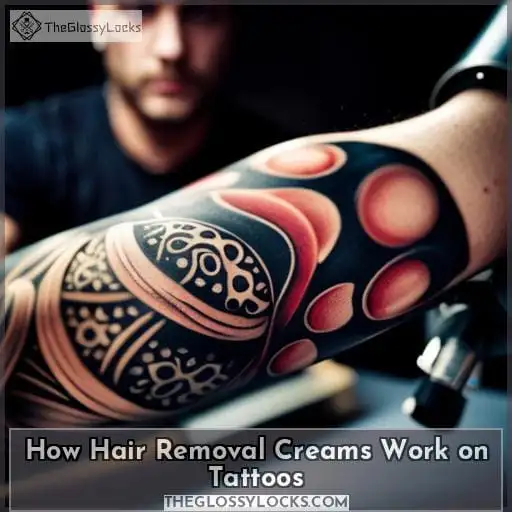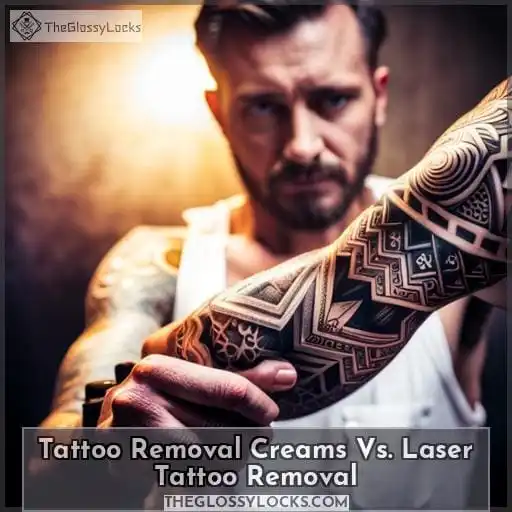This site is supported by our readers. We may earn a commission, at no cost to you, if you purchase through links.
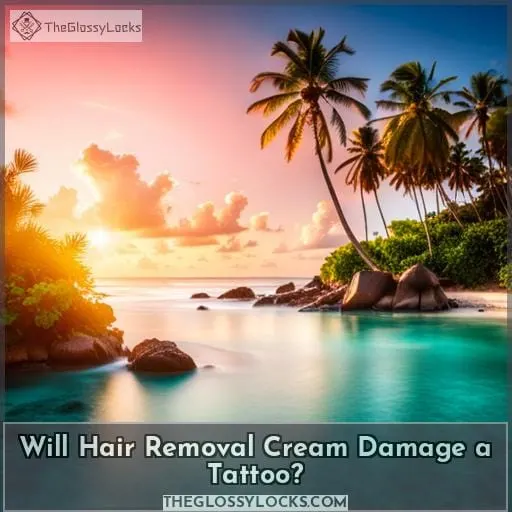
In this article, we’ll dive into this common concern and provide you with expert insights. We’ll explore safe methods for removing hair near tattoos and discuss how these creams work on inked skin. Discover everything you need to know about keeping your tattoo intact while achieving smooth skin.
Table Of Contents
- Key Takeaways
- Shaving Before Getting a Tattoo
- Shaving After Getting a Tattoo
- Safe Hair Removal Methods for Tattoos
- Protecting Your Tattoo During Hair Removal
- Timing and Tattoo Healing
- How Hair Removal Creams Work on Tattoos
- Tattoo Removal Creams Vs. Laser Tattoo Removal
- Frequently Asked Questions (FAQs)
- Can I use hair removal cream on a fresh tattoo?
- Will hair removal cream fade or affect the color of my tattoo?
- Can I use hair removal cream on a tattoo that is still healing?
- Are there any specific precautions I should take when using hair removal cream on a tattooed area?
- How long should I wait after using hair removal cream before getting a new tattoo?
- Conclusion
Key Takeaways
- Hair removal creams do not damage tattoo ink in the dermis.
- Proper usage of hair removal creams is important for safe tattoo maintenance.
- Patch testing is recommended for individuals with sensitive skin.
- Consider individual sensitivities and preferences when choosing grooming methods for tattooed skin.
Shaving Before Getting a Tattoo
Before getting a tattoo, it’s recommended that you shave the area for optimal results.
Shaving before a tattoo has several benefits.
Firstly, it allows the tattoo artist to work on clean and hair-free skin, making the process easier and more efficient.
Secondly, shaving helps prevent bacterial contamination by removing any potential sources of dirt or bacteria from the area being tattooed.
Additionally, shaving can reduce skin irritation during and after the tattooing process.
When preparing for your tattoo appointment, you have two options when it comes to shaving: you can either do it yourself at home or let your tattoo artist handle it for you.
If you choose to shave at home before your appointment, make sure to use a clean razor and take care not to nick or cut yourself in order to avoid unnecessary pain or complications.
In conclusion, including pre-tattoo preparation steps such as shaving can contribute significantly towards ensuring a successful outcome with minimal discomfort during both application and healing phases of tattoos.
Shaving After Getting a Tattoo
Now that we’ve discussed the importance of shaving before getting a tattoo, let’s move on to the topic of shaving after getting a tattoo.
Once your tattoo is fully healed, you may be wondering if it’s safe to shave the area where your new ink resides. Shaving post-tattoo requires careful consideration and proper maintenance to ensure both your skin and artwork remain in optimal condition.
Tattoo artists often shave the area before tattooing for ease of application, but once the healing process is complete, whether or not to continue shaving is entirely up to personal preference. Some individuals choose to remove hair around their tattoos for improved visibility and aesthetics, while others prefer leaving their body hair untouched.
If you decide that shaving after getting a tattoo aligns with your preferences and comfort level, it’s essential to practice proper aftercare techniques during this process. Be mindful of using gentle strokes when removing hair near or directly over the freshly healed inked areas as vigorous rubbing could potentially damage or fade parts of your design.
Remember that maintaining adequate moisture through daily lotioning can help enhance overall appearance while protecting against dryness-induced itchiness commonly associated with newly shaven skin.
Safe Hair Removal Methods for Tattoos
When it comes to safely removing hair from tattooed skin, there are several methods you can consider.
- Shaving is a quick and affordable option that can be done at home, while waxing offers longer-lasting results but may be more painful.
- Depilatory creams are another safe choice for tattooed skin, as long as the product instructions are followed carefully.
- Finally, electrolysis is a permanent hair removal method that may require professional assistance but guarantees long-term results.
Consider your preferences and pain tolerance when deciding which method is best for you and your tattoos.
Shaving
If you want to remove hair from your tattooed area, consider using a safe and effective method like shaving.
- Shaving is a quick and affordable way to remove hair.
- It helps prevent bacterial contamination and irritation.
Wait until the tattoo is fully healed before shaving.
- Protect your tattoo during the process for best results.
Waxing
To safely remove hair from your tattooed skin, waxing is a viable option. Waxing precautions should be taken to ensure the safety and protection of your tattoo.
Follow proper waxing tips and aftercare to maintain the integrity of your ink.
Compare waxing vs shaving for optimal results.
Depilatory Cream
You can safely remove hair from your tattooed skin using a depilatory cream. It’s a convenient and effective method for maintaining the appearance of your tattoo sleeve. By following proper cream application techniques, you can ensure tattoo compatibility, skin safety, and avoid potential issues like skin discoloration or allergic reactions.
Electrolysis
Before undergoing electrolysis for hair removal on your tattooed skin, it’s important to understand the potential effects and considerations.
Electrolysis is a safe and effective method that offers permanent hair removal. It works by targeting individual hair follicles with electrical currents, damaging them to prevent future growth.
Unlike other methods, electrolysis can be used on any skin tone or type and doesn’t cause damage to tattoos located in the dermis below the epidermis.
Consider alternatives such as shaving or depilatory creams before opting for electrolysis.
Protecting Your Tattoo During Hair Removal
When it comes to hair removal, protecting your tattoo is essential. While removing unwanted hair around your tattoo can enhance its visibility and maintain its appearance, it’s crucial to take precautions to ensure that the process doesn’t damage or fade your ink.
To protect your tattoo during hair removal, there are a few key steps you should follow.
First and foremost, make sure that your tattoo is fully healed before using any hair removal methods near the area.
Next, choose safe and gentle methods for removing hair around your tattooed skin. Shaving with a clean razor or using depilatory creams specifically designed for sensitive skin are often recommended options.
During the actual process of applying these products or shaving cream onto the surrounding areas of the tattooed skin surface should be done carefully by avoiding direct contact with tattoos themselves as much as possible while adequately moisturizing right afterward helps in maintaining both healthy looking tattoos along without causing harm from irritation due overly dryness potentially caused by repeated application over time.
By following these guidelines and being mindful of how you remove unwanted body hair near sensitive areas like tattoos, you can effectively manage hair growth without compromising the integrity of your tattoo.
It’s important to remember that every individual is unique, and what works for one person may not work for another. When in doubt, it’s always best to consult with a tattoo professional or skincare expert who can provide personalized recommendations for tailoring a safe care and maintenance plan for your tattoo.
Timing and Tattoo Healing
During the timing and healing process of your tattoo, it’s important to consider when hair removal should be done. Proper care and protection are crucial to ensure the best outcome for your tattoo.
Here are three key points about timing and tattoo healing:
- Wait for complete healing:
It’s recommended to wait approximately two weeks for your tattoo to fully heal before attempting any hair removal methods.
- Consult with your artist:
If you’re unsure about the healing status of your tattoo, it’s always a good idea to consult with your trusted tattoo artist before proceeding with any hair removal procedures.
- Enhance visibility after hair removal:
Once the surrounding area is free from unwanted body hair through safe methods like shaving or depilatory cream application following product instructions), you may notice that the visibility of your beautiful artwork improves even more.
By considering these aspects during both timing and healing processes along with proper aftercare routines such as gentle cleaning using an antibacterial soap like Dial Gold Antibacterial Soap and moisturizing daily with Aquaphor Healing Ointment Moisturize (both suitable options for tattoos), you can maintain optimal results while safely removing unwanted body hair around tattoos.
How Hair Removal Creams Work on Tattoos
To understand how hair removal creams work on tattoos, it’s important to know that these creams dissolve the hair on the epidermis.
When applied to the skin, the active ingredients in the cream break down proteins in the hair strands, weakening them until they can be easily wiped away.
However, it’s crucial to note that tattoo ink is embedded deeper into the dermis layer of skin and isn’t affected by surface-level treatments like hair removal creams.
Despite this, caution should still be exercised when using these products around tattoos to avoid any potential adverse reactions or damage.
Here are three key points about how hair removal creams work on tattoos:
- Tattoo compatibility: Hair removal creams don’t affect tattoo ink as they primarily target and remove surface-level hairs.
- Cream effectiveness: These products effectively dissolve unwanted body or facial hairs but have no impact on permanent tattoo pigment.
Tattoo Removal Creams Vs. Laser Tattoo Removal
If you’re considering removing a tattoo, you may be wondering how tattoo removal creams compare to laser tattoo removal.
| Tattoo Removal Creams | Laser Tattoo Removal | |
|---|---|---|
| Effectiveness in Fading Tattoos | Less effective than laser treatment as they only target the surface layer of the skin and may not penetrate deeply enough to fade tattoos significantly. | Highly effective at breaking down ink pigments deep within the skin, resulting in significant fading or complete removal of tattoos over multiple sessions. |
| Cost of Treatment Effectiveness: High Cost: Low-ModerateEffectiveness: Very high Cost: High-Expensive | ||
Treatment DurationProlonged use required for noticeable resultsSignificantly shorter treatment time with visible results after each session
Skin ReactionsMay cause irritation or allergic reactions due to chemical ingredientsMild discomfort and temporary side effects such as redness, swelling, and blistering are possible but generally subside quickly
While both methods have their pros and cons, it’s important to consider factors like effectiveness, cost, duration of treatment, and potential skin reactions when deciding on a suitable option for your tattoo removal journey.
Consulting with a professional dermatologist or aesthetician can provide valuable guidance based on your specific needs.
Laser tattoo removal has been proven highly effective in fading or completely removing tattoos compared to tattoo removal creams.
Frequently Asked Questions (FAQs)
Can I use hair removal cream on a fresh tattoo?
Using hair removal cream on a fresh tattoo isn’t recommended.
It’s important to wait until the tattoo is fully healed before considering any hair removal methods, as applying creams may cause irritation or damage to the ink.
Will hair removal cream fade or affect the color of my tattoo?
Hair removal cream doesn’t adversely affect the color of your tattoo.
When used correctly, it removes hair from the surrounding area without causing damage or fading to your ink.
Enjoy smooth skin and vibrant tattoos simultaneously.
Can I use hair removal cream on a tattoo that is still healing?
Using hair removal cream on a healing tattoo isn’t recommended.
Wait until your tattoo is fully healed before considering hair removal methods.
Prioritize proper aftercare to ensure the best outcome for your tattoo.
Are there any specific precautions I should take when using hair removal cream on a tattooed area?
When using hair removal cream on a tattooed area, take precautions to avoid potential damage.
- Perform a patch test first.
- Ensure the tattoo is fully healed.
- Follow manufacturer’s instructions.
- Never apply near sensitive areas.
- Never apply more than twice in 48 hours.
How long should I wait after using hair removal cream before getting a new tattoo?
After using hair removal cream, it’s recommended to wait at least two weeks before getting a new tattoo.
This allows the skin to fully heal and reduces the risk of irritation or damage to the fresh tattoo.
Conclusion
In the world of tattoos, the fear of damaging your precious artwork with hair removal cream is a common concern. However, rest assured that when used properly, hair removal creams won’t harm your tattoo.
There are safe methods for removing hair near tattoos, such as shaving, waxing, and using depilatory creams.
It’s important to protect your tattoo during the hair removal process, and consider the timing of hair removal in relation to your tattoo’s healing.
Overall, you can achieve smooth skin without compromising your tattoo’s integrity.

